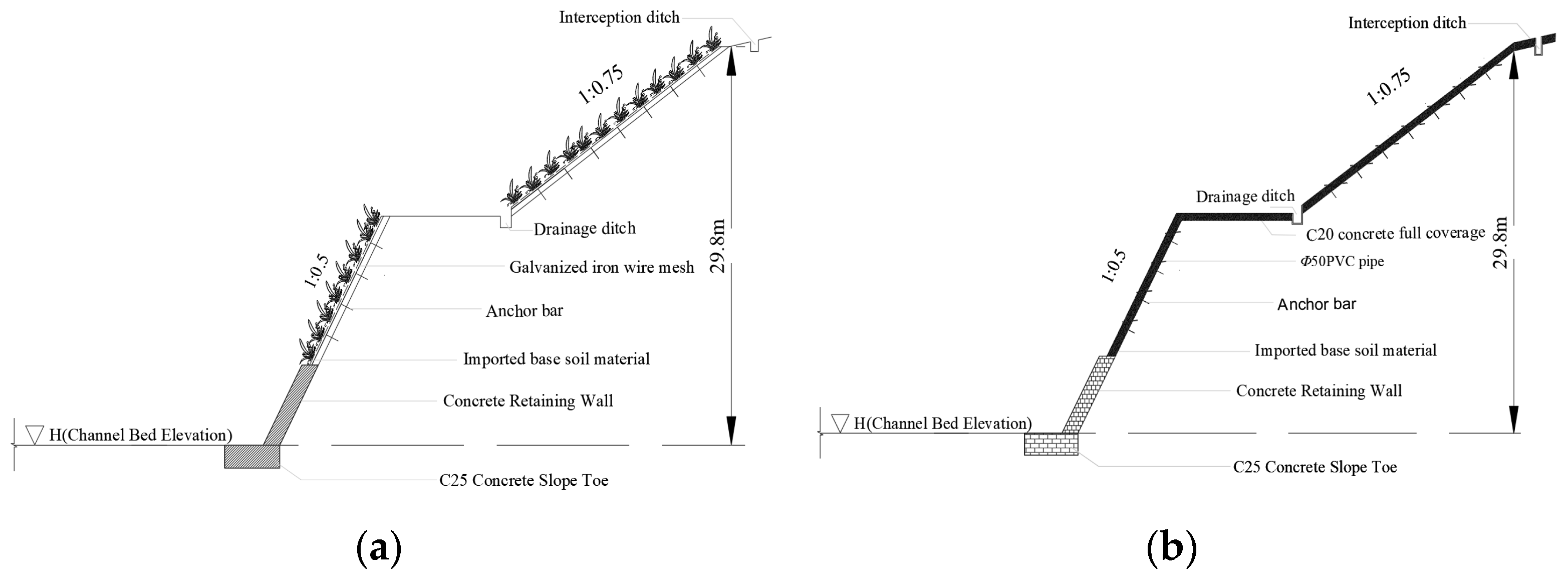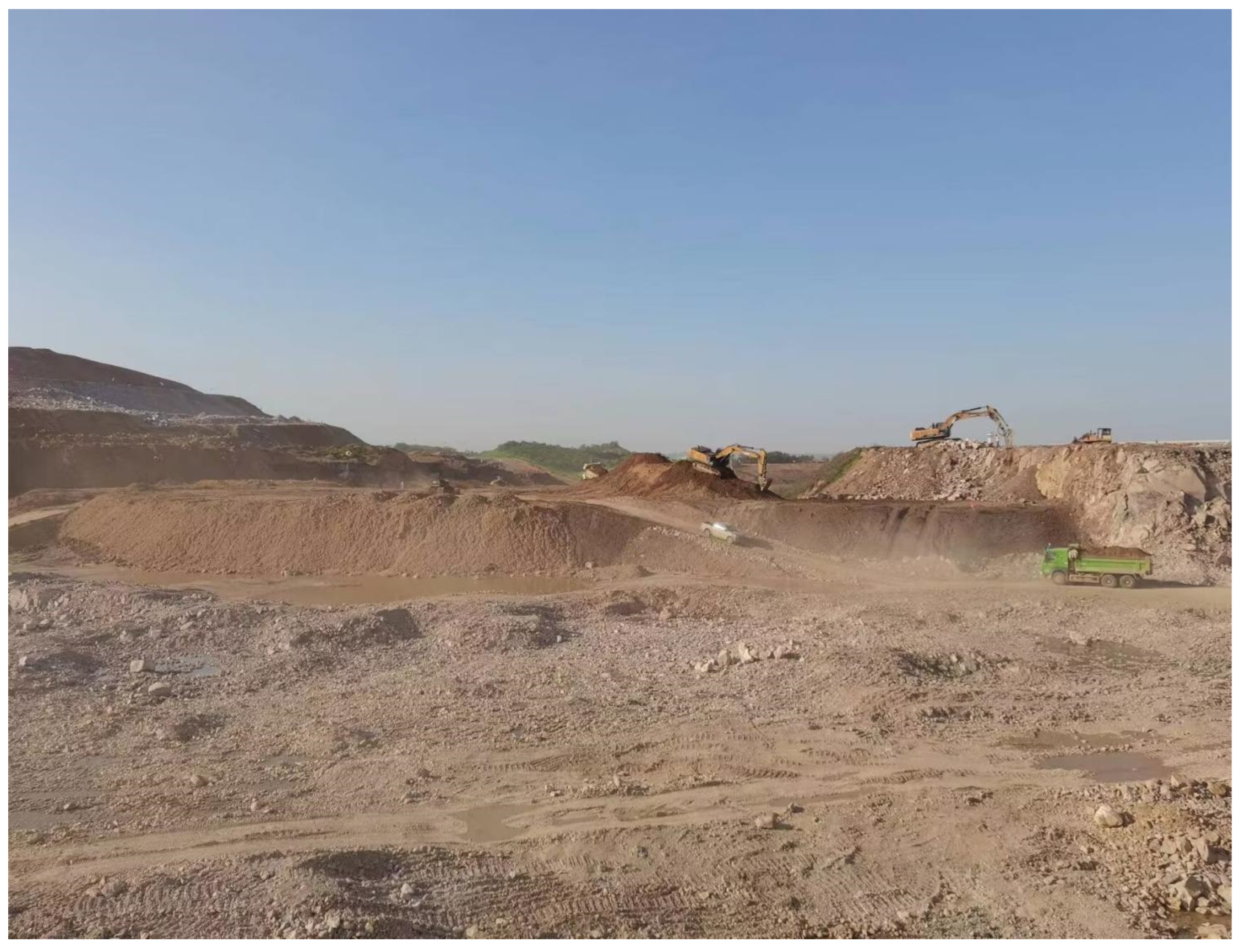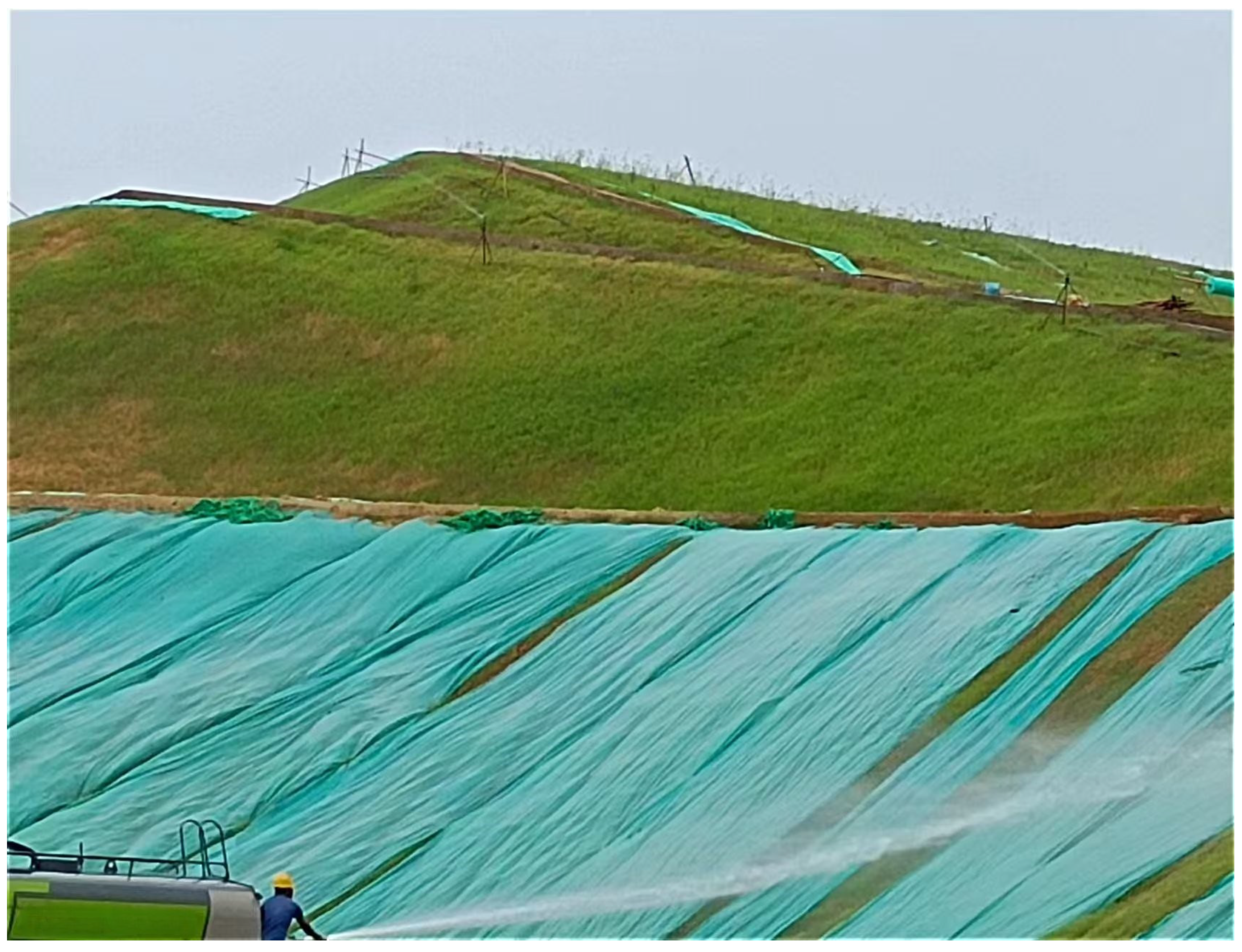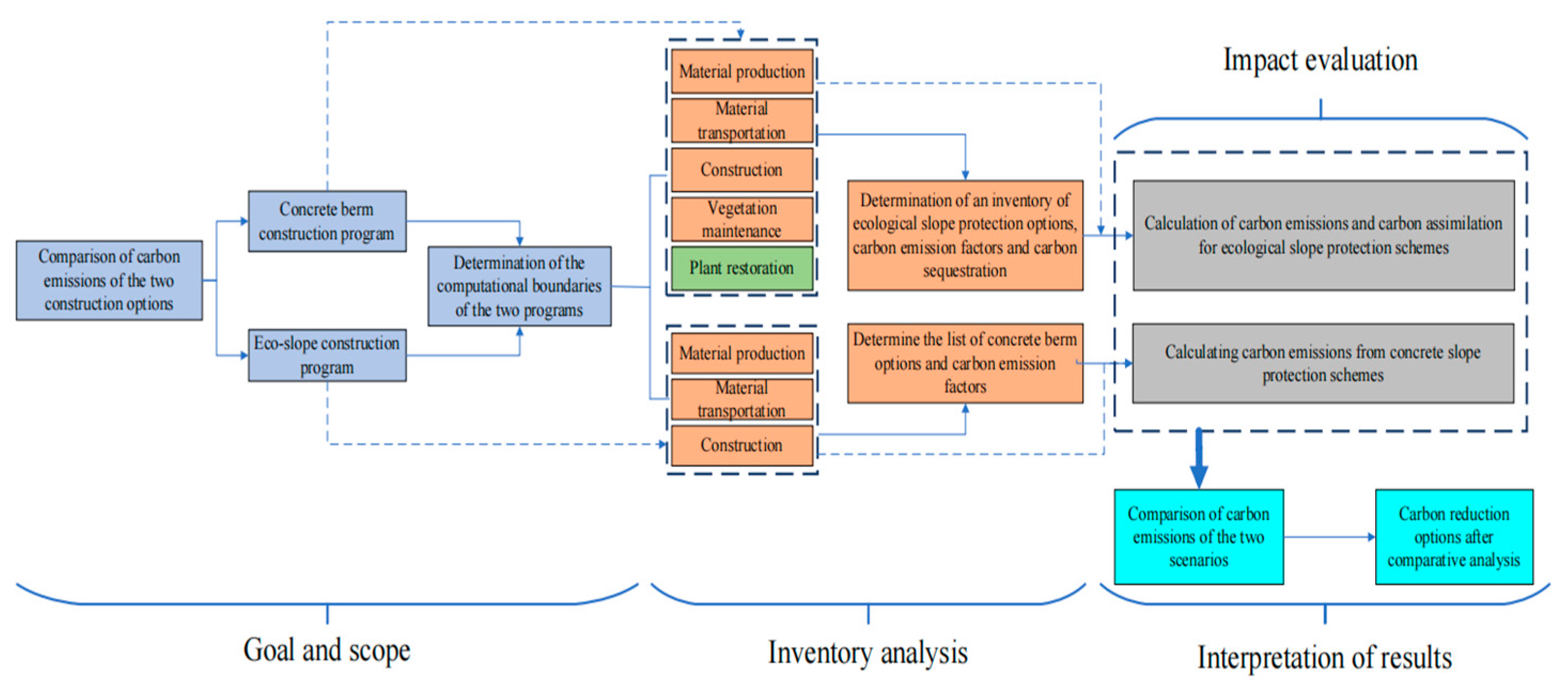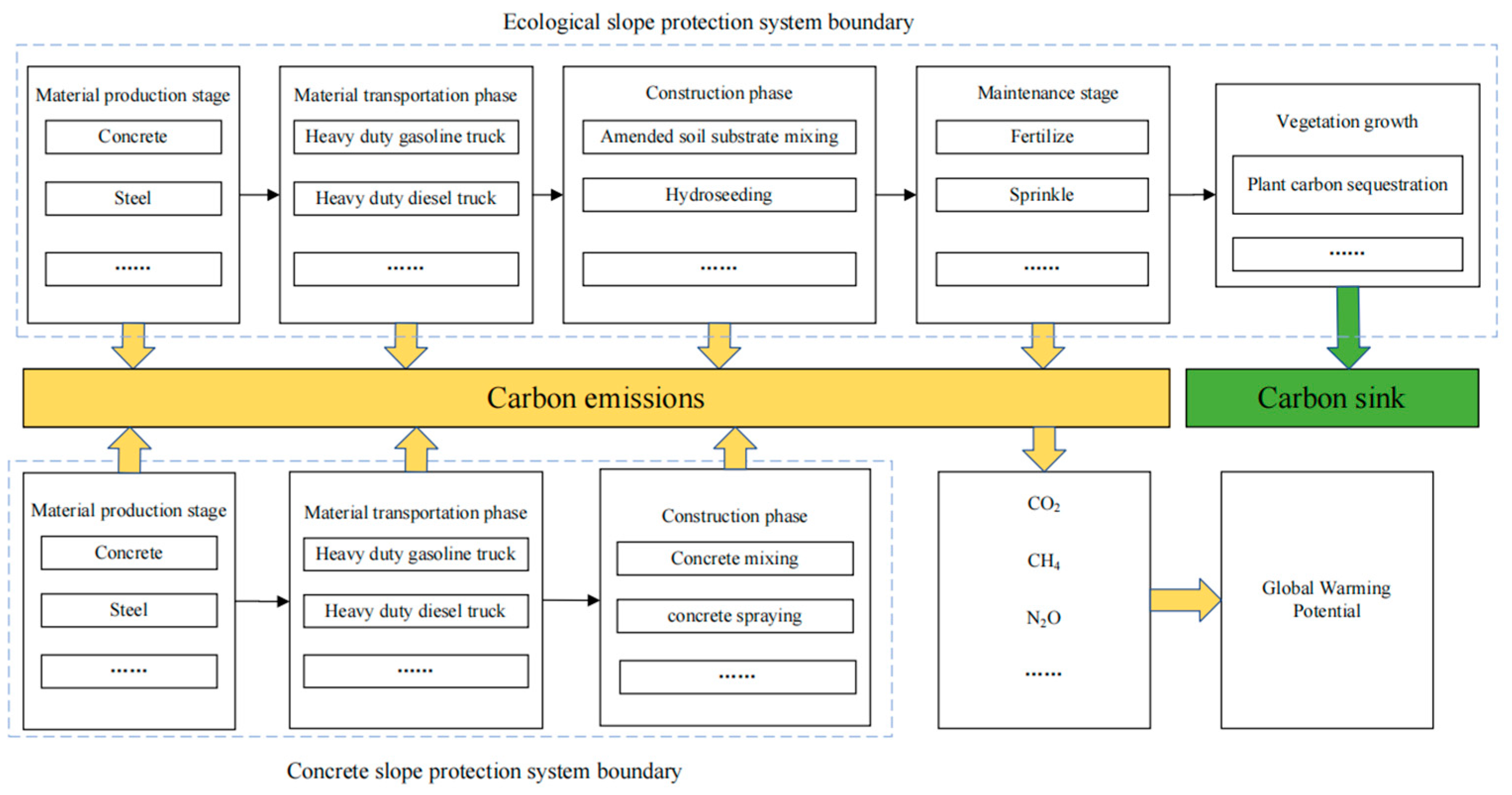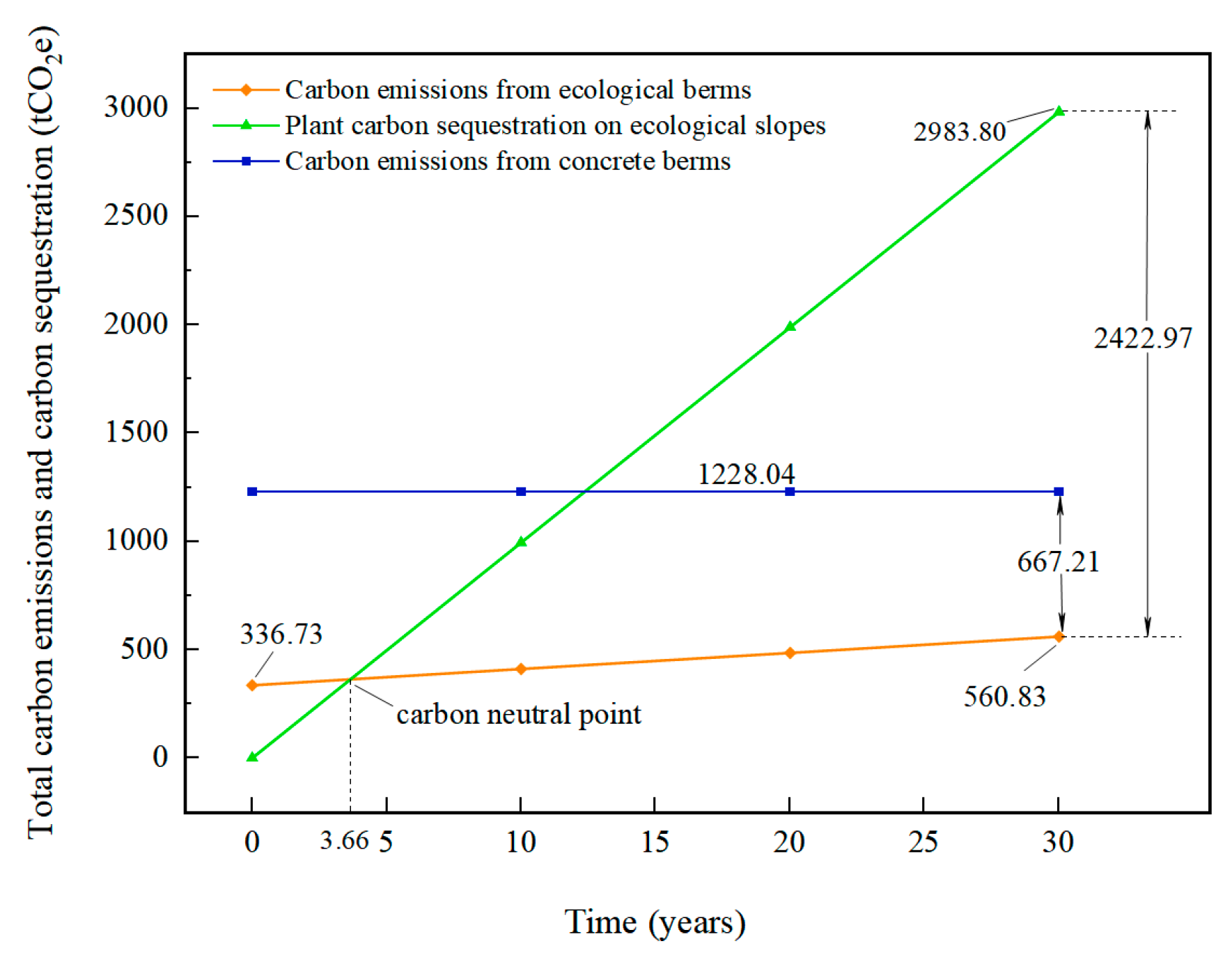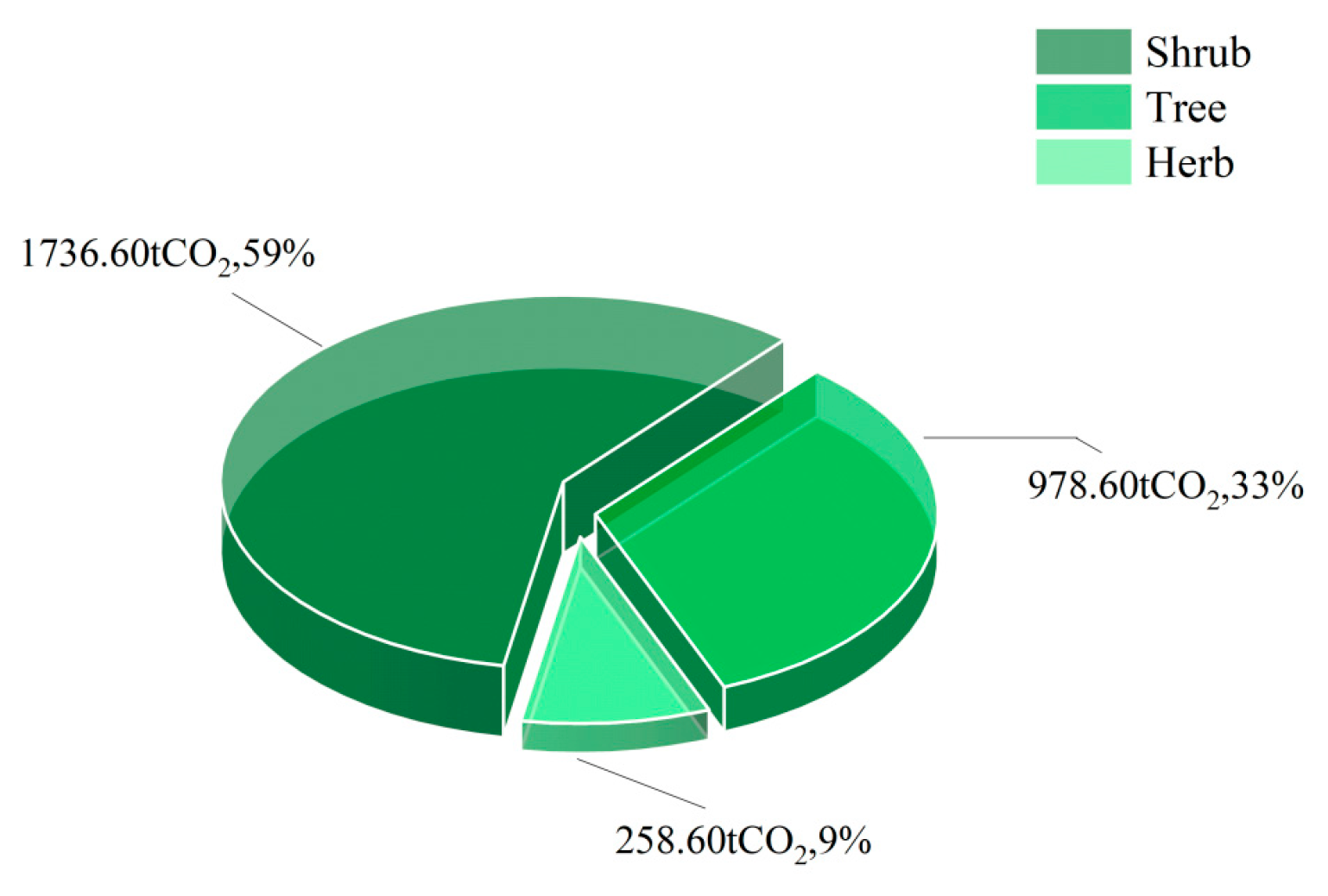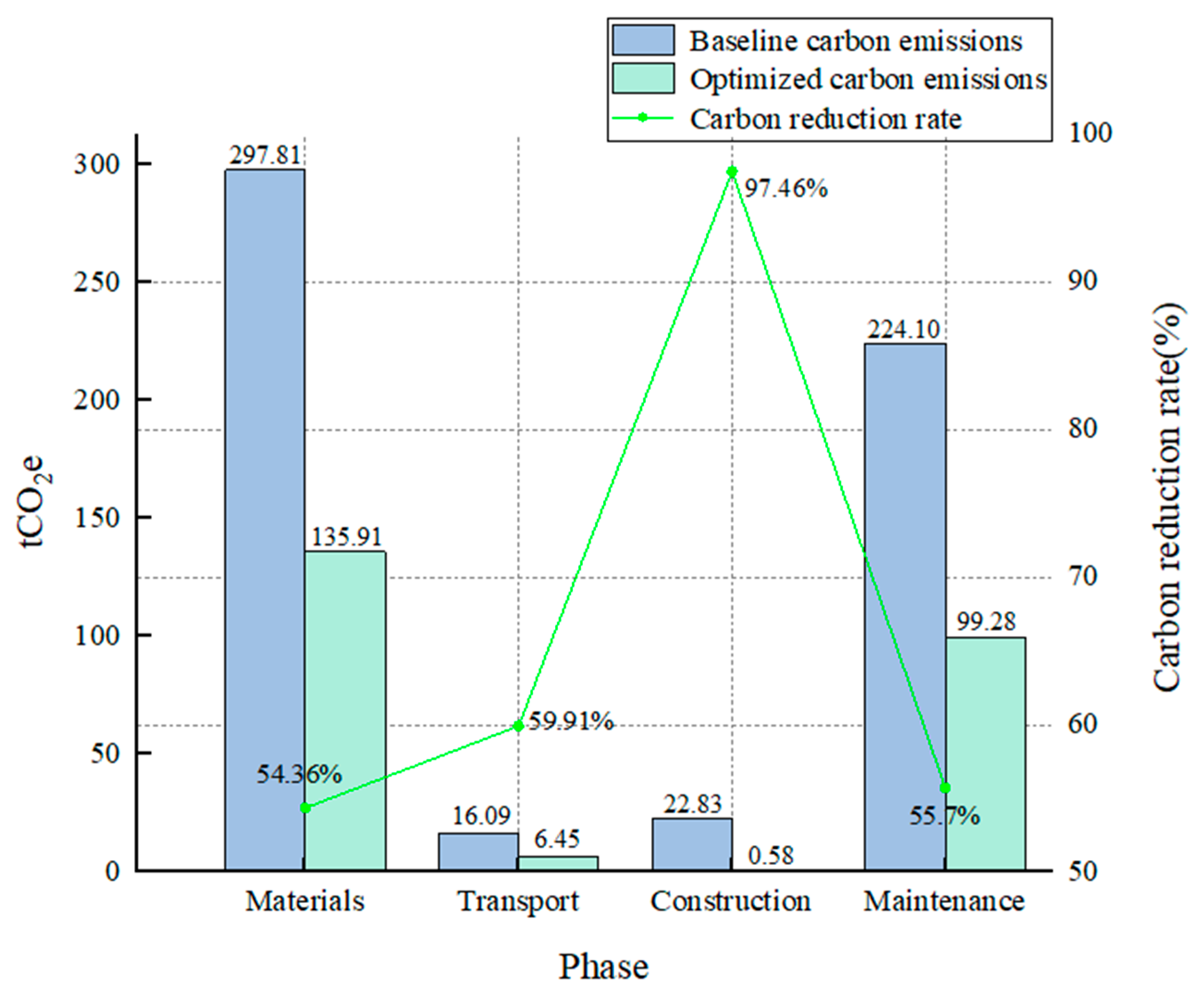1. Introduction
In recent years, climate change has altered rainfall patterns, with frequent heavy rainfall penetrating exposed slope soils. This increases the weight and saturation of the soil, thereby reducing its strength and significantly decreasing slope stability, making it more prone to disasters like collapses and landslides [
1,
2]. Although traditional riverbank slope protection (concrete slope protection) can enhance slope stability, reduce erosion, and provide flood control, its stability generally deteriorates over time. The slope safety factor steadily decreases by 2.3% to 2.4% annually, impacting its protective function [
3,
4]. Moreover, rigid materials block the exchange of matter and energy between the water and the slope soil matrix, significantly weakening the ecological effects of slope protection. This neglects the river ecosystem and its environment for plants, animals, and microorganisms, disrupting the water ecological cycle [
5]. Additionally, concrete slope protection relies heavily on high-carbon materials like cement, concrete, and steel, increasing carbon dioxide concentrations, which exacerbate global warming and environmental issues, such as natural disasters [
6]. This construction method has highlighted its contradiction with the goal of sustainable development.
According to the Copernicus Climate Change Service’s meteorological monitoring report, 2024 is projected to be the hottest year on record, with the global average temperature surpassing the 1.5 °C threshold set by the Paris Agreement for pre-industrial levels. This poses a significant challenge to global climate efforts [
7]. Considering the construction industry’s substantial impact on greenhouse gas emissions and the increasing global attention on climate change, the sector has become a central focus in the transition to sustainable building practices [
8]. To align with ecological sustainability goals and reconcile slope stability with ecological benefits, the concept of ecological protection has been increasingly applied to artificial slope construction and management [
9]. Unlike traditional riverbank slope protection methods, ecological slope protection strengthens the soil through an intricate network of plant roots, significantly increasing the shear strength of the slope’s shallow soil layer. Deep-rooted anchorage and lateral root traction further enhance the overall stability of the slope. Furthermore, vegetation slows surface runoff, reduces the erosive impact of rainwater on the slope, and decreases soil erosion, aiding in water conservation and soil stabilization. This innovative integration of civil engineering and plant materials is increasingly applied in modern slope protection projects [
10,
11,
12]. Ecologically friendly slope construction methods prioritize natural materials like soil, plant roots, and gravel, reducing reliance on high-energy materials. This leads to a simpler construction process, shorter cycles, and reduced machinery use, among other benefits. Consequently, carbon emissions from constructing ecological slopes are significantly lower than those from structural slopes [
13]. In response to climate change, ecological slope protection harnesses the carbon sequestration and oxygen release capabilities of plants to absorb carbon dioxide, offsetting emissions from slope construction. This provides the project with carbon neutrality potential and enables significant carbon sequestration over its lifecycle [
14].
However, it is crucial to acknowledge that these sustainability benefits are not without potential trade-offs. As noted, ecological slope protection also presents limitations. In canal rivers exposed to flash floods or high-velocity flows, vegetation cover and soil substrates are vulnerable to erosion before root systems are sufficiently developed. Severe flooding may compromise slope integrity, leading to partial or complete failure. Such failures often require costly maintenance or reconstruction, which can offset anticipated carbon benefits by generating additional emissions [
15]. Therefore, a comprehensive evaluation of ecological slope protection must extend beyond its carbon sequestration potential to include its resilience and durability under extreme conditions. From a life-cycle perspective, optimizing design and construction is essential to improve performance and minimize carbon footprints across all project stages, even under disruptive events.
Although a life-cycle perspective is essential, most studies on slope-related carbon emissions analyze a single construction method in isolation and rarely compare processes or quantify stage-specific abatement potential. To address this gap, this study examines a built riverbank protection project and, using LCA, compares both stage-wise and total emissions across alternative construction schemes. The analysis identifies effective abatement strategies and translates them into targeted design and construction optimizations, thereby strengthening the methodological basis for life-cycle carbon assessment of ecological slope protection.
2. Study Area
The Huama Lake Water System Connecting Canal Ecological Slope Protection Project is situated in Xinyuan Village, Shawo Township, Ezhou City, Hubei Province. The total length of the Xinyuan section is 1.0564 km (from LT3+000 to LT3+256.4 and YJ0+000 to YJ0+800). The lake spans 20.07 km2, with a total length of 2.2 km, a design flow rate of 80 m3/s, a slope range of 15–80°, and a water storage depth of 4.3 m. The canal also passes through two peaks over 50 m high. The slopes along the canal are typical steep rock slopes, with some sections comprising mixed rock-soil and soil slopes.
This study takes the Xinwan section (YJ0+000–YJ0+800)—Phase I of the Huama Lake project—as the object of analysis. This section consists of typical steep rock slopes, with slope gradients of approximately 40–75°. The elevation difference from the canal bed to the intercepting ditch at the slope crest ranges from 5 to 67 m, and the protected slope area is about 31,000 m
2. At the design stage, a fully paved C20 concrete slope protection scheme was originally planned for this section. However, in view of ecological conservation and landscape requirements, the final implementation adopted a combined form: a cast-in-place concrete retaining wall at the lower part and sprayed-soil ecological slope protection at the upper part. The main construction procedures included the following: installing crest intercepting ditches and slope drainage ditches (cross-section 60 cm × 60 cm); placing long and short anchor rods on the slope surface with wire mesh or local rebar mesh (Φ6.5 mm, 500 mm × 500 mm); and then spraying a 10–12 cm thick soil substrate to form the ecological slope protection.
Figure 1 illustrates the sprayed-soil ecological slope protection scheme;
Figure 2 shows the early-stage construction process;
Figure 3 depicts vegetation watering and maintenance during the later stage; and
Figure 4 presents the vegetation restoration after completion.
The project features typical geological conditions of riverbank slope protection in central China and simultaneously incorporates both the originally designed concrete slope protection scheme and the actually implemented ecological slope protection scheme. Because the two schemes are comparable under the same geographical conditions and functional requirements, this project provides a unique context for conducting a life-cycle carbon emission comparison of different slope protection approaches and offers substantial practical reference value. This study selects the Huama Lake Phase I project as the case for three reasons: (1) the same slope was constructed using two different schemes, which naturally controls for external differences such as geological and hydrological conditions and thereby enhances the comparability and validity of the quantified carbon-emission contrast; (2) the case has a well-defined system boundary and clear stage delineation, and data on energy and material consumption at each stage can be obtained from the project budget, construction logs, and material lists, ensuring empirical robustness and operability; and (3) under these conditions, a standardized analytical workflow and methodology can be established within a consistent boundary and accounting framework, providing a replicable pathway for life-cycle carbon-emission assessments of other types of scheme changes.
5. Discussion
The research results show that the ecological slope protection scheme has an additional carbon emission source during the maintenance phase compared to the concrete slope protection scheme. However, its total carbon emissions are significantly lower than those of the concrete slope protection scheme. This is due to the use of more natural materials, such as local soil, plant fibers, and organic matter, reducing reliance on high-carbon materials like steel and concrete. Since the material production phase accounts for the largest share of carbon emissions, the total emissions are reduced. Additionally, carbon emissions generated during the ecological slope protection maintenance phase are offset by carbon sequestration during the plant growth phase, achieving the goal of “reducing carbon emissions and increasing carbon sequestration.” Furthermore, one month after completion of the ecological slope protection, plant coverage exceeds 90%, and slope stability is significantly improved through the action of plant roots [
47,
48]. This aligns with the current concept of green transformation in building structures and confirms the feasibility of ecological slope protection as a low-carbon, ecologically stable construction solution.
The research found that while ecological slope protection offers a significant carbon emission advantage over concrete slope protection, there is still substantial potential for further carbon reduction optimization. The proposed optimization plan includes improvements in material selection, transportation equipment, energy models, and vegetation maintenance, further reducing the carbon footprint of ecological slope protection. It is acknowledged that ecological solutions may introduce increased maintenance activities, such as monitoring plant health and managing irrigation systems, compared to inert concrete structures. The proposed optimizations are precisely aimed at mitigating these additional labor demands and their associated carbon costs. These optimization strategies can promote the widespread application of low-carbon buildings and infrastructure, aiding in the achievement of stricter carbon emission targets.
From a carbon sequestration perspective, plants are crucial for achieving negative carbon emissions. The ecological slope protection plan prioritizes native plants that are highly adaptable and possess strong carbon sequestration potential. In Northeast and North China, shrubs with strong carbon sequestration potential, such as sea buckthorn, common lespedeza, and black locust, are commonly used. These are combined with trees and herbaceous plants to create a “tree-shrub-herb” three-dimensional slope protection structure. This structure enhances slope stability and erosion resistance while providing the ecological slope protection plan with the practical potential to achieve “carbon neutrality” and even a “carbon surplus.” In contrast, invasive plants suppress the potential for carbon sequestration through biological interactions. However, they exhibit greater tolerance to harsh slope environments, such as saline-alkali, drought, or nutrient-poor conditions [
49,
50]. Therefore, based on specific slope conditions, strategically introducing invasive plants can enhance carbon sequestration benefits and ecological stability in slope protection.
This study proposes carbon reduction optimization measures for the ecological slope protection maintenance phase, including the introduction of a rainwater collection and drip irrigation system to reduce reliance on tap water. Additionally, precise irrigation techniques are employed to reduce water consumption, energy usage, and labor-related carbon emissions [
51]. The rainwater collection system effectively stores rainfall, providing an irrigation water source for ecological slope protection and reducing demand for municipal water supply. This reduces tap water usage and associated human-induced carbon emissions. However, in arid regions, the effectiveness of this solution is limited. Due to scarce precipitation in these regions, the collected rainwater is insufficient to meet plant needs, causing the drip irrigation system to function intermittently and reducing overall carbon reduction effectiveness. In regions with limited water resources, operating the drip irrigation system may increase energy consumption, potentially offsetting the carbon reduction benefits of the technology. Therefore, in arid regions, future optimization during the maintenance phase should combine multiple water source allocation and soil moisture management techniques to improve water use efficiency and vegetation growth stability. The economic and environmental feasibility of these measures must be evaluated against the long-term benefits, with region-specific cost-benefit analysis being crucial.
In the material production phase of ecological slope protection, low-carbon materials such as low-carbon cement, recycled concrete, and recycled steel are utilized as optimization strategies. These low-carbon materials significantly reduce carbon emissions during the construction phase while maintaining the structure’s strength. Research has shown that the carbon reduction rate using these materials can reach up to 54.36%. However, despite their excellent carbon reduction performance, their economic feasibility in practical applications must also be considered. For example, recycled concrete is 0–10% more expensive than virgin concrete [
52]. For some projects, low-carbon materials may be an efficient and environmentally friendly option, but their high initial cost may need to be recovered through long-term energy savings and emission reduction benefits. To ensure their feasibility, project decision-makers must assess whether the use of these materials aligns with budget requirements while considering long-term environmental benefits and economic returns. Therefore, when implementing low-carbon materials, balancing carbon emission reduction with cost control is a key issue that must be addressed. Overall, the cost of the sprayed-soil ecological slope protection scheme is approximately 740,000 RMB, while the cost of the concrete slope protection scheme is around 1,680,000 RMB. This is due to the shorter construction period of the ecological slope protection scheme, which results in lower labor and equipment costs, as well as differences in material selection. This indicates that the sprayed-soil ecological slope protection scheme is more cost-effective. However, it should be noted that a concrete slope-protection scheme requires only light watering for curing after completion and can be put into service once it hardens. In contrast, a sprayed-topsoil ecological slope requires vegetation maintenance during the first few years after completion, with maintenance costs of approximately RMB 86,034 per year, which gradually decrease as the vegetation becomes established and stabilized. Therefore, the ecological slope-protection scheme still demonstrates cost suitability.
As global attention on climate change increases, carbon trading markets are gradually maturing. Governments and international organizations have established carbon emission trading mechanisms, providing economic incentives for emission reduction projects through market-based approaches. Ecological slope protection, as an effective low-carbon construction solution, can quantify and certify the net carbon sequestration within the vegetation’s lifecycle. The project can convert this carbon sequestration into carbon credits and participate in market trading, offsetting the initial investment and potentially higher maintenance costs and achieving long-term economic returns, thereby promoting a positive cycle between environmental and economic benefits. As the project’s operational lifespan extends, the carbon sequestration effect continues to accumulate, and its ecological value becomes more evident. Economic returns also grow over time, further enhancing the project’s sustainability and investment appeal. Furthermore, the carbon trading mechanism provides a practical incentive scheme for low-carbon construction approaches, such as ecological slope protection. This not only expands financing opportunities for green projects but also provides valuable insights for other infrastructure projects undergoing low-carbon transformation, highlighting the important role of ecological governance in addressing climate change and promoting environmental sustainability. Although vegetation carbon sequestration gives ecological slope protection the potential to be converted into carbon credits and enter the market, converting it into tradable and certifiable credits requires several key conditions: clearly defined accounting boundaries and time horizons (e.g., 20–30 years); a robust and verifiable monitoring–reporting–verification (MRV) system; demonstration of baseline and additionality; management of permanence risks and leakage; and compliance with recognized third-party certification standards. In addition, the market value of carbon credits must be the net of monitoring, verification, registration, and transaction costs, with a risk buffer reserved. As this represents only a potential opportunity, this study offers only a qualitative discussion of the issue.
In our project design, we also considered a range of construction solutions, including wet-sprayed vegetated shotcrete slope protection, lattice-beam (frame) slope protection, and eco-bag slope protection. Based on a common functional requirement, we evaluated wet-sprayed vegetated concrete, lattice-beam frameworks, eco-bag systems, and sprayed-topsoil ecological protection. The wet-sprayed facing provides higher initial stiffness and better erosion control, but it increases carbon emissions during material production and fabrication and restricts deep-root growth. The lattice-beam solution enhances confinement yet does so at the cost of greater concrete/steel demand, added construction complexity, and a larger footprint. Eco-bags are flexible but require additional setback space and careful drainage, and they face durability and maintenance challenges under heavy rainfall. Given the site’s controllable geometry and exposure—and the absence of a requirement for immediate ultra-low-deformation performance—the sprayed-topsoil scheme, using locally blended materials, can rapidly establish vegetation cover and benefit from root reinforcement, offering the most appropriate balance for this project.
The main limitations of this study include the following: (1) When comparing the carbon emissions of different slope construction schemes, the concrete slope protection scheme is only a preliminary design and has not been implemented. Its transportation distance and construction equipment energy consumption are based on default values from engineering quotas and the China Building Carbon Emission Calculation Standard (GB/T 51366-2019), meaning that the results from comparing its carbon emissions with those of the ecological slope protection scheme may not reflect actual conditions [
25]. (2) In the plant carbon sequestration assessment, annual average carbon sequestration data for the plants were referenced from existing literature, representing the carbon absorption capacity of the plants in a stable growth state. However, the carbon sequestration benefits of plants are influenced by environmental factors, slope gradients, and interspecies competition. In actual ecological slope protection projects, the carbon absorption capacity of plants may vary due to these factors. (3) This study does not include the potential carbon emissions from the proposed reservoir and irrigation pipeline network within the LCA boundaries. The idea of introducing rainwater collection and drip irrigation is aimed at reducing dependence on tap water and carbon emissions. However, the construction of the water storage tank and related infrastructure may also result in additional carbon emissions. This impact should be considered in a comprehensive LCA to determine whether the overall carbon reduction benefits are truly achieved or whether they are offset by the construction and maintenance of these systems. (4) The decarbonized concrete slope protection construction solution, as a combination of structural stability and ecological integration, cannot be quantified as a complete new solution in this study due to the inability to obtain localized LCI data for specific decarbonized concrete. In the future, a LCA should be conducted for decarbonized concrete projects to enable a comparative analysis with other construction solutions. (5) Research on low-carbon materials, new types of transportation equipment, and energy structures is currently limited, with corresponding data sources for carbon emission factors related to low-carbon footprint elements being scarce. This limits the accuracy of the carbon reduction optimization analysis.
6. Conclusions
(1) This research extensively examines the carbon reduction potential of Phase I of the Huama Lake ecological slope protection project, comparing the ecological slope protection approach with the conventional concrete slope protection method through LCA. A detailed analytical framework was established to monitor the carbon footprint of both construction options. The findings reveal that the ecological slope protection scheme outperforms the concrete one, reducing emissions by 667.21 tons. The project is expected to achieve carbon neutrality within 3.66 years through long-term carbon absorption by the plants. The study found that in the ecological slope protection scheme, the carbon sequestration capacity of the plants is the core driving force behind carbon reduction, a factor that may have been underestimated in slope carbon emission studies.
(2) During the first three months after the construction of the sprayed-soil ecological slope protection, the sprayed layer underwent four heavy rainfall events, with the maximum rainfall exceeding 100 mm. Despite several storms, the substrate successfully covered the majority of the slope surface and wire mesh. Some localized areas, such as steep slopes (e.g., inverted slopes or areas with water infiltration), experienced some runoff and detachment. The issue of the wire mesh not being fully covered was addressed by rerouting water flow and supplementary spraying. The intercepting ditches at the top of the slope successfully captured rainwater from the surrounding mountains, preventing direct water flow erosion on the slope. Between the completion of the sprayed layer and plant germination, the slope experienced minor surface erosion and rill formation (with an average depth of approximately 1–2 mm) during heavy rainfall events. However, as vegetation rapidly grew, the plant cover increasingly strengthened, reducing the impact of rainwater erosion. Additionally, the reinforcing effect of plant root systems further enhanced the substrate’s resistance to erosion. After two months, the slope exhibited excellent water and soil retention, with clear runoff during heavy rainfall events. This demonstrates the long-term effectiveness of the sprayed-soil ecological slope protection solution.
(3) Additionally, this study explores methods for further reducing carbon emissions in the ecological slope protection scheme. The carbon reduction optimization plan addresses various stages that generate carbon emissions, focusing on the primary carbon sources at each stage. Practical carbon reduction measures were summarized, including low-carbon cement, recycled concrete, and recycled steel, as well as electric transport vehicles, clean energy generation, organic fertilization methods, and rainwater collection for drip irrigation. The results show that implementing these carbon reduction strategies can further reduce carbon emissions by 318.6 tons, building on the ecological slope protection scheme’s existing carbon reduction benefits. This provides significant support for global climate change mitigation and offers valuable insights for constructing other low-carbon projects.
(4) The study also emphasizes that ecological slope protection projects, as part of civil engineering, are intrinsically linked to climate and environmental changes. By integrating modern technologies and innovative methods, future ecological slope protection projects can leverage technologies such as the Internet of Things (IoT) and Geographic Information Systems (GIS) to monitor key variables in real-time, including plant growth, soil moisture, and climate change. This enables a more precise assessment of the project’s carbon sequestration effects and provides scientifically informed spatial planning solutions for its implementation. Through interdisciplinary collaboration across civil engineering, climate science, and environmental economics, comprehensive solutions can be developed to promote the green transformation of civil engineering projects and strengthen responses to climate change.
(5) In addition to the explored solutions, emerging alternatives such as concrete with carbon sequestration or decarbonation capabilities are worth considering. These alternatives present exciting potential for further reducing carbon emissions in construction projects. As research in this field advances, the integration of such materials could provide more opportunities for carbon mitigation. Future studies could explore how these advanced materials compare to traditional ecological and concrete slope protection methods, offering more sustainable solutions for long-term construction projects.
